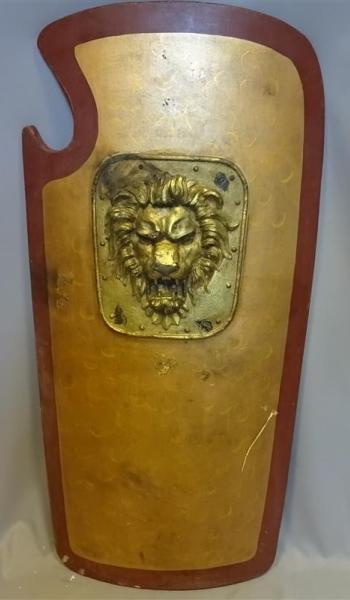I've spent some time in the past thinking about Tower Shields, but since I've been playing a character who uses one, I've figured out a few more things -- inspired by actual play and by comments on the Paizo Message Boards.
 Specifically, what if enemies start sundering your beloved Tower Shield? Keep in mind that although Tower Shields have to be made of wood (sorry, no adamantine ones), you can boost any item's hardness and hit points by making it magical.
Specifically, what if enemies start sundering your beloved Tower Shield? Keep in mind that although Tower Shields have to be made of wood (sorry, no adamantine ones), you can boost any item's hardness and hit points by making it magical.
A Base Tower Shield has Hardness 5 and 20 hp.
However, "Add +2 [to Hardness] for each +1 enhancement bonus of magic items ... Add 10 hp for each +1 enhancement bonus of magic items."
So a +2 Tower Shield has Hardness 9 and 40 hp.
If you happen to be Large in size, for example, if you are a liontaur or centaur, then double the base hit points (20 x2 = 40). Then add more for being magical. A +2 Tower Shield sized for a Large creature has 60 hp and hardness 9.
Darkwood has the same number of hit points and base hardness, but half the weight, which is nice. For just an extra 450 gp (+900 for a large creature, but still worth it), I think.
Don't forget to keep your shield in great shape. Spells like Mending and Make Whole are very nice, but they have a casting time of 10 minutes, so they are useful between battles, not during.
The best way to keep your Tower Shield in great shape is to to your best to prevent damage in the first place. Before the hardness or hp of your shield even matters, an enemy has to successfully hit your CMD with a sunder attack. Therefore, anything you can do to boost your CMD is a good thing. Per the rules, "A creature can also add any circumstance, deflection, dodge, insight, luck, morale, profane, and sacred bonuses to AC to its CMD." That means your Ring of Protection, your Dodge feat, and your +1 AC Ioun Stone all boost your CMD, so make sure you prioritize those options over, say, an Amulet of Natural Armor or Bracers of Defense.
Also consider feats that are designed to boost your CMD, such as Shield Specialization (from the APG) and Defensive Combat Training (from the Core rules). The former lets you apply your +4 shield bonus to your CMD, so it is great at low levels; the latter lets you use your hit dice in place of your BAB to calculate CMD, so it is great at higher levels if you are not a fighter-type.
Finally, although the visuals may or may not appeal to you, consider the advantage of using two shields. Use a Large Shield (spiked, if you like, or just regular for bashing) in one hand and your Tower Shield in the other. You cannot use the Shield bonus from both at the same time; they do not stack -- you have to use the better one. So you have two choices: Choice One, use your Tower Shield for its AC bonus and your Large Shield to bash enemies. Or Choice Two, use your Tower Shield for total cover and your Large Shield for its bonus to AC from the other directions.
And with the Improved Shield Bash feat, you can even use your Tower Shield for total cover, use your Large Shield for its bonus to AC, and bash foes as well -- at least, if they provoke Attacks of Opportunity. If your DM uses hero points, you can use a Hero Point for an extra standard action to gain total cover, and use your remaining full attack to bash (multiple times if you have BAB +6 or higher or a haste effect, say).
Some folks may say, "Wait a minute! If your Tower Shield is up, how come your foe does not get total cover from you?" Well, remember that although a Tower Shield grants total cover to you against enemy attacks, when you make attacks (such as Attacks of Opportunity or an extra attack with a hero point), your enemy does not have total cover from you! The rules say, "As a standard action, however, you can use a tower shield to grant you total cover until the beginning of your next turn." That is YOU gain total cover. No other creature gains total cover. If you want a visual that makes sense, imagine that you lower or move aside your Tower Shield when you attack, but lift it back up quick the moment you are done with your swing.
But note that a Tower Shield is still quite viable if you are not a shield-bashing warrior. My arcane casting liontaur carries one and loves it. He uses verbal only spells mostly, like True Strike and Suggestion. Or he casts long duration buffs like Mage Armor. Or he uses a move action to loose this shield, then casts with a standard action, then equips it again next round, maybe after casting a second spell.
So if you are clever, there are a lot of ways to get good use out of a Tower Shield.